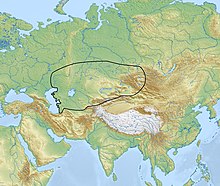Andronovo culture
Appearance

The Andronovo culture is a collection of similar local Late Bronze Age cultures that flourished c.2000–1450 BC, in western Siberia and the central Eurasian Steppe. Some researchers have preferred to term it an archaeological complex or archaeological horizon. The older Sintashta culture (2200–1800 BC), formerly included within the Andronovo culture, is now considered separately to Early Andronovo cultures.
Quotes
[edit]- In the history of Southern Siberia the Andronovo culture was of special importance. Its most southerly monuments are to be found in the foothills of the Altai; the most northerly ones are in the Ob region in the zones between the forest and the steppe.
- Denis Sinor, "The Concept of Inner Asia", in The Cambridge History of Early Inner Asia (1990), p. 83

